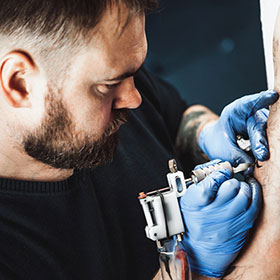Yes, forearm tattoos can hurt. The pain varies for each person.
Factors like pain tolerance, tattoo size, and artist skill affect the experience. Getting a tattoo is a personal journey. Many people wonder about the pain, especially for forearm tattoos. The forearm is a popular spot due to its visibility and ease of access.
Pain levels can differ greatly. Some find the process mildly uncomfortable, while others feel more intense pain. It’s important to prepare mentally and physically. Understanding what to expect can ease your anxiety. In this post, we’ll explore the factors influencing pain and share tips to help you manage it. Let’s dive in and uncover the truths about forearm tattoo pain.
Forearm Tattoo Pain Levels
Many factors can affect the pain of a forearm tattoo. The tattoo size matters. Bigger tattoos take longer, causing more pain. Tattoo location also plays a role. Inner forearms might hurt more than outer areas. Tattoo design is another factor. Designs with many details can hurt more. Tattoo artist skill is key. Experienced artists can help reduce pain.
Everyone feels pain differently. Some people have high pain tolerance. They might not feel much pain. Others have low pain tolerance. They might find the process very painful. Stress levels can also affect pain. Feeling calm can help reduce pain. Pain threshold varies by person. Knowing your own can help you prepare.
Anatomy Of The Forearm
Forearm tattoos can be painful due to the thin skin and proximity to bones and nerves. Pain varies by individual.
Muscles And Skin
The forearm has many muscles and tendons. These muscles help you move your hand and fingers. The skin on the forearm is not too thick. It can be more sensitive than other body parts. Tattoo needles must go through this skin to reach the dermis. Some areas may hurt more than others. For example, the inner forearm may feel more pain.
Nerve Endings
Nerve endings are all over the forearm. These nerves send pain signals to the brain. The more nerve endings, the more pain you might feel. Some people have more sensitive nerves. This can make tattoos feel more painful. The outer forearm has fewer nerves than the inner part. This can mean less pain on the outer side. Everyone’s pain level is different. It also depends on the tattoo artist’s skill.
Pain Compared To Other Areas
Getting a tattoo on the upper arm hurts less than the forearm. The upper arm has more muscle, which cushions the needle. The forearm has less muscle and more nerves. So, it feels more painful.
Forearm tattoos hurt, but ribcage tattoos hurt more. The skin on the ribs is thin and close to the bone. This makes the pain more intense. The forearm has more flesh, so the pain is less severe.
Pain Management Techniques
Topical numbing creams can help reduce pain. They are applied to the skin before the tattoo. These creams work by numbing the area. This makes the tattoo process more comfortable. Always talk to your tattoo artist about using these creams. Some creams work better than others. It’s best to try a small amount first. This avoids any allergic reactions.
Breathing techniques can help manage pain. Deep breathing helps you stay calm. Breathe in slowly through your nose. Hold your breath for a few seconds. Then breathe out slowly through your mouth. Repeat this pattern. It helps you focus on your breath, not the pain. Some people find this very helpful. Practice this before your tattoo appointment. It will make you more prepared.
Pre-tattoo Preparations
Drink plenty of water before your tattoo session. It keeps your skin hydrated. Hydrated skin is easier to tattoo and heals faster. Get a good night’s sleep. Being well-rested helps your body handle pain better. Tired bodies are more sensitive to pain.
Avoid alcohol for at least 24 hours before your tattoo. Alcohol thins your blood and can cause more bleeding. This makes the process harder for the artist. Skip caffeine too. It can make you jittery and increase your heart rate. Staying calm helps the tattoo process go smoothly.
During The Tattoo Session
Talking to your artist can help ease your nerves. Let them know if you feel pain. They can adjust the pressure. This makes the experience better for you. A good artist will check on you often. They want you to feel comfortable. Open communication helps the session go smoothly.
It is okay to ask for breaks. Short breaks can give your body time to rest. This can reduce the pain. Drinking water during breaks can help too. Staying hydrated is important. Some people bring snacks to keep their energy up. Breaks make the process easier to handle.
Aftercare For Comfort
Forearm tattoos can cause discomfort, especially over bony areas. Proper aftercare helps manage pain and ensures healing. Keep the area clean and moisturized.
Moisturizing And Cleaning
Keep your tattoo clean. Use mild soap and water. Pat it dry gently. Apply a thin layer of fragrance-free moisturizer. Do this several times a day. It helps keep your skin soft. It also prevents itching and dryness.
Avoiding Direct Sunlight
Avoid the sun. Keep your tattoo covered. Sunlight can fade the ink. Sunburn can damage your skin. If you go outside, wear long sleeves. Use sunscreen if your tattoo is exposed. Choose one with high SPF. It protects your tattoo and skin.
Personal Experiences
Some say forearm tattoos are not very painful. The skin here is thicker. Pain is often described as mild. Others feel a bit more discomfort. For them, it feels like a constant scratching. Most agree, the pain is bearable. Aftercare is important. Keeping the area clean helps with healing.
Many artists agree forearm tattoos are less painful. The area has fewer nerve endings. Technique matters. A skilled artist can reduce discomfort. Hydration helps. Drink water before your session. This keeps the skin healthy. Relaxation is key. Stay calm to feel less pain. Overall, forearm tattoos are manageable.
Conclusion
Forearm tattoos hurt, but pain levels vary. Some feel mild discomfort. Others experience more intense pain. Your pain tolerance matters. Tattoo artists can help minimize discomfort. Proper aftercare speeds up healing. Do your research before getting inked. Choose a reputable artist.
Forearm tattoos can be a beautiful choice. Plan well and embrace your new art.

